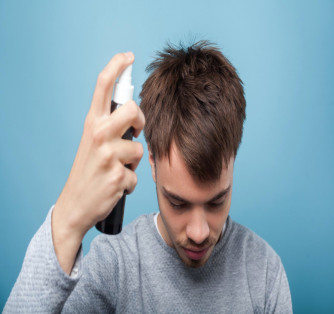Menu
Weight loss
Hormones
Sex
EXPLORE
MEET NU IMAGE MEDICAL
TREATMENTS
MEET NU IMAGE MEDICAL
TREATMENTS
MEET NU IMAGE MEDICAL
Topical Finasteride vs. Oral Finasteride: What's The Difference?


Androgenic alopecia, more commonly referred to as male pattern baldness, is a common type of hair loss condition experienced by men. According to data from the U.S. National Library of Medicine (NLM), more than 50% of men older than 50 are affected by the condition to an extent, bringing in the need for treatment and prevention.
While oils, herbal preparations, and OTC treatments can help reintroduce growth in some parts of the scalp, they can't stimulate it enough to manage the condition effectively. This is where prescription drugs like Finasteride come in. Finasteride directly affects androgens to prevent hair loss and encourage hair growth.
The treatment comes in two forms: oral and topical. Below we look at the difference between these forms and learn more about their capabilities.
Overview of Finasteride
Finasteride was designed in the 1980s by a company called Merck. The 5mg version of the drug received FDA approval in 1992 to treat benign prostate hyperplasia, and the 1mg version graced the markets in 1997 when it was recognized and approved as a hair loss treatment for conditions such as androgenic alopecia (male pattern hair loss) in men.
Oral 1mg Finasteride was later recreated in a topical form that was not FDA-approved but possessed the same hair-preserving effects. The oral and topical forms use the same active ingredient, finasteride, and the same mechanism of action.
They are both classed as 5-alpha-reductase inhibitors (5-ARI). Once applied/consumed, Finasteride stops the function of the 5-alpha-reductase enzymes, which are responsible for converting testosterone to dihydrotestosterone (DHT) hormone.
DHT plays a significant role in causing hair loss and male pattern baldness, which explains why this drug is used for hair loss. DHT can attach to receptors in hair follicles, causing them to become smaller, resulting in a gradual loss of hair across the scalp, crown, and around the hairline.
Finasteride reduces the amount of DHT in the body by stopping the conversions, which protects hair follicles from damage and stunted growth. A clinical study in the Journal of Investigative Dermatology showed that the use of the treatment reduces DHT levels in the body by 70%.
This results in slowed hair loss and, in some cases, stops hair loss completely. It was shown that some men might notice substantial hair growth in affected areas of the scalp with the use of finasteride.
Topical Finasteride vs Oral Finasteride
We've established that Finasteride comes in two forms: topical and oral. Both forms use the same approach and active ingredient to carry out their function, so where does the difference come in? After extensive research, we found that the split in forms came from side effects. Oral Finasteride didn't sit well with different patient groups and proved an issue for those unable to consume tablets.
The topical version was developed so users could receive the direct therapeutic effects of the active ingredient in the hair follicles instead of waiting for it to pass several systems and affect the entire body.
The primary differences between topical and oral Finasteride are listed below:
-
Composition and Potency
The Finasteride pill contains 1mg of the active ingredient, while the topical formulation uses just 0.1% of the active compound. The difference in the active ingredient volume means that one form is more potent than the other. This is one of the reasons why professionals prescribe the oral or topical form in accordance with the severity of the androgenic alopecia experienced.
Oral Finasteride is always created using a single active ingredient, whereas topical Finasteride is available in versions containing other active compounds as well. For example, there is topical Finasteride with just one active ingredient (finasteride) and topical Finasteride with 2 active ingredients (finasteride and minoxidil).
Minoxidil is a scientifically backed hair loss agent that can support Finasteride in its function. It shortens the resting growth stages, pushing hair follicles into a growing stage. This allows the topical version to combat hair loss from another angle to improve outcomes and produce holistic results. A study published on NCBI showed that 84% of patients maintained good hair density when they used the finasteride-minoxidil combination.
Even with discontinuation, the combination still showed good effects when the treatment was resumed. Since minoxidil is a beneficial addition to finasteride, most patients combine oral Finasteride with topical Minoxidil use to achieve better results.
-
Availability and Price
The tablet form is manufactured around the world, so it is relatively cheap and accessible. The topical formulation has to be compounded by a compounding chemist. This individual specially creates a treatment for patients who cannot take commercially-available drugs. They have the right experience and equipment to make a stable topical Finasteride cream. Since the process is costly, difficult, and takes a while, the medicine is harder to access and can be pricey.
The Effectiveness and Safety of Oral and Topical Finasteride
Research data and patient reviews show no significant difference between the two forms regarding efficacy and safety. However, the side effects of oral use bring down the rate of successful outcomes as users tend to discontinue treatment, falter with adherence, or experience setbacks.
Let's look at the associated studies below:
-
Topical Finasteride:
Multiple studies show that topical Finasteride is very effective in treating hair loss, in some cases, results comparable with oral finasteride. The efficacy is maintained with patient adherence, which is higher with topical finasteride.
-A study comparing the effectiveness of topical Finasteride and tablets showed exactly this—patients in both groups (oral and topical) had substantially reduced hair loss, demonstrating the effectiveness of the treatments. However, topical users showed better adherence.
-A 2014 study showed that plasma DHT was reduced by 75% with the use of topical finasteride, compared to tablet administration, which reduced DHT by 62% to 72%. This study showed that topical application could be more effective than oral Finasteride in some cases.
*Both studies produced strong evidence demonstrating that topical Finasteride does not display as many unpleasant side effects as the oral version.
-A 2016 study observed the side effects of oral Finasteride with topical application in patients aged 18 to 40 years old. The results showed that only 2 patients that were given the topical treatment experienced a mild burning sensation on the scalp. No patients complained of sexual side effects with topical administration. This concludes that topical Finasteride is well-tolerated among all patients.
-
Oral Finasteride:
Oral Finasteride has been researched quite extensively over the years. The effectiveness and safety of the product always produced mixed results, with some trials proving its excellent safety and efficacy profiles and others showing the wavering line of safety.
-A five-year PubMed study contained two groups of men; one group took a daily tablet of Finasteride, and the other took a placebo. The study showed that 90% of men taking oral Finasteride found that their hair loss stopped within 12 months, and 66% even noticed regrowth.
In comparison, the placebo group experienced increased hair loss. Looking further into the results, oral Finasteride showed good improvement in hair appearance and density. The study also confirmed that the oral treatment was well-tolerated, with no safety concerns in long-term use.
A PubMed study showed that oral Finasteride taken by a group of men with androgenic alopecia experienced an improvement in hair growth and hair quality. However, side effects were experienced, causing a disruption in the treatment plan. This is one of the instances where efficacy is present, and safety is wavering.
The difference in safety and efficacy clearly differs by a very small margin but differs nonetheless. The safety of the topical version seems shatterproof, while the oral version brings in some side effect risks. While the efficacy of both options seems on par with each other, some professionals pin oral Finasteride as the more effective option.
This is because of its effect on DHT. DHT, the culprit behind androgenic alopecia, is made in the liver and is transported to the scalp through the bloodstream. Oral Finasteride is able to stop the production of the hormone at the root since it's consumed orally, showing a higher efficacy rate.
Finasteride Side Effects
As we mentioned earlier, oral Finasteride comes in with a higher side effect profile, which is the primary reason for the growing interest in topical Finasteride. Oral Finasteride is, of course, consumed by mouth, which means it has access to the entire body through the bloodstream. This allows it to impact hormones in a significant way. While this is great for effectiveness, it isn't ideal for safety.
Finasteride essentially works to combat hair loss by stopping testosterone conversion. Since the oral version is consumed, it remains present in the bloodstream much longer than the topical version, affecting testosterone levels for an extended time which induces symptoms of sexual dysfunction.
A collection of studies showed that sexual side effect occurs 2.1% to 3.8% of the time with oral finasteride, which means 1 in 20 men can experience sexual dysfunction. This can include erectile dysfunction, ejaculatory dysfunction, and reduced sexual desire. Although a small number of users experience sexual side effects, it still raises concerns for men who want to use the medicine.
Other common side effects associated with oral Finasteride use include:
-
Bloating
-
Skin rashes
-
Redness of the skin
-
Swelling of the face, hands, arms, lower legs, or feet
These side effects are more easily reversed than the sexual side effects and often have a mild to moderate disposition. It should be noted that 96% of men who use oral treatment generally report no side effects.
Since topical Finasteride is more localized and applied on the scalp, its effects do not linger, eliminating the possibility of sexual side effects. However, this doesn't mean that side effects are completely absent.
Common side effects associated with topical Finasteride include:
-
Skin redness
-
Contact dermatitis
-
Scalp pruritus (itchy scalp)
-
Burning sensation on the scalp
These side effects are slightly more manageable than the ones associated with the oral version and can be alleviated with OTC medicines or home remedies.
Which One Should You Choose?
Finasteride, whether in topical or oral tablet form, should only be used by men who are experiencing male pattern baldness and want effective treatment. While both forms of finasteride can produce the same results and restore hair growth, men lean towards topical Finasteride to avoid the possibility of unpleasant side effects.
If your main concern is side effects, then topical Finasteride is the better option for you. However, it might not be ideal if you have sensitive skin on the scalp, dandruff, oily scalp, or other scalp issues, as this might cause severe irritation, leading you away from your original goal of hair regrowth. It all comes down to differing individual and condition factors.
8 Sources
Nu Image Medical has strict sourcing guidelines to ensure our content is accurate and current. We rely on peer-reviewed studies, academic research institutions, and medical associations. We strive to use primary sources and refrain from using tertiary references.
http://ghr.nlm.nih.gov/condition/androgenetic-alopecia
https://www.sciencedirect.com/science/article/pii/S0022202X15529357
https://www.ncbi.nlm.nih.gov/pmc/articles/PMC4314881/
http://www.bioline.org.br/pdf?dv09011
https://www.ncbi.nlm.nih.gov/pmc/articles/PMC6609098/
https://pubmed.ncbi.nlm.nih.gov/11809594/
https://www.ncbi.nlm.nih.gov/pmc/articles/PMC3481923/
This article is for informational purposes only and does not constitute medical advice. The information contained herein is not a substitute for and should never be relied upon for professional medical advice. Always talk to your physician about the risks and benefits of any treatment. Nu Image Medical may not offer the medications or services mentioned in this article.
